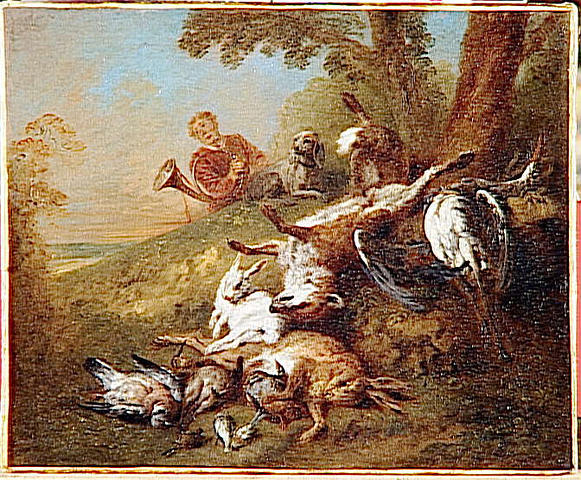
- Home Page
- Accepted
Paintings & Copies - Doubtful
Attributions - Doubtful Textual References
- Alternative
Titles - Collectors &
Museums - Bibliography
- Search Abecedario
- Watteau &
His Circle
X. Gibier mort
Entered September 2015; revised January 2017

Paris, Musée du Louvre, inv. M.I. 1130.
Oil on canvas
37.5 x 46 cm
ALTERNATIVE TITLES
Gibier dans un payage
Gibier et sonneur de trompe dans un paysage
Gibier mort et sonneur de trompe
Sonneur de cor
PROVENANCE
Paris, collection Charles Ledru. His sale, Paris, Hôtel des ventes mobilières, April 21, 1852, lot 54: “[WATTEAU] Gibier dans un Paysage. — Un Sonneur de cor. Watteau, dans ce petit tableau, rivalise, par sa candeur et sa finesse, avec les tableaux flamands les plus recherchés.” Sold for 350 francs according to an annotated copy of the catalogue in the Frick Art Reference Library.
Paris, collection Adolphe Dugléré (1805-1884; cook and restauranteur). His sale, Paris, Hôtel des ventes mobilières, January 31, 1853, lot 96: “DU MÊME [WATTEAU (ANT.)] . . . Plusieurs pièces de gibier sont déposée au pied d’un arbre; plus loin, un chasseur et son chien. Toile. – Haut., 36 c. Larg, 45 c.” Sold for 400 francs to “Mr Coster,” according to an annotated copy of the sale catalogue in the Frick Art Reference Library.
Paris, collection of Dr. Louis La Caze (1798-1869; physician); donated to the Musée du Louvre in 1869.
EXHIBITIONS
Paris, Louvre, Copies, répliques, pastiches (1973), cat. 86 (as by Pater, Gibier mort et sonneur de trompe, Musée du Louvre).
SELECT BIBLIOGRAPHY
Paris, Louvre, Tableaux legués par M. La Caze (1871), cat. 269
Brière, Louvre, catalogue de peintures (1924), cat. 993.
Ingersoll-Smouse, Pater (1928), cat. 378.
Adhémar, Watteau (1950), cat. 244.
Macchia and Montagni, L’opera completa di Watteau (1968), cat. 8o-K.
Paris, Louvre, Catalogue illustré (1974), 2: cat. 630.
Faroult and Eloy, La Collection La Caze (2007), 270.
Faroult and Eloy, La Collection La Caze CD-ROM (2007), 696-97.
REMARKS
In the mid-nineteenth century, including when it was in the La Caze collection, this picture was thought to be by Watteau. But by the time it entered the Louvre, the attribution was being approached with caution. The 1870 catalogue of the La Caze collection judiciously labeled the painting “attribué à Watteau.” A half century later, Brière still listed it as attributed to Watteau. Just a few years afterwards, Ingersoll-Smouse recognized Pater’s authorship. Her re-attribution has rightly remained in place ever since, save that in the 2007 exhibition of the La Caze collection the classification was again downgraded to “entourage de” Pater. Vogtherr is recorded as seeing two hands in the picture, neither of which, he thinks, is Pater's.
This type of Flemish seventeenth-century still life, be it a game piece or kitchen scene, was quite popular in France in the first decades of the early eighteenth century, and certainly in Watteau’s circle, as in the master’s Cuisinière in Strasbourg and the many works by Lancret, Chantereau, and, not least of all, Chardin. However, Pater seems not to have been attracted to this type of subject beyond this one example.